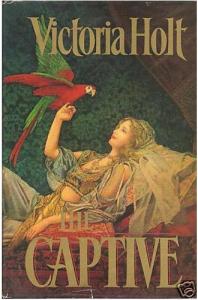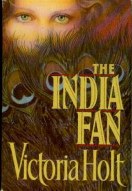The Captive
The Captive by Victoria Holt
Doubleday, 1st edition, 1989
357 pages
Genre: Gothic romance, historical romance, romantic suspense
Synopsis & Review: Rosetta Cranleigh is of a genteel background; her parents are both respected scholars of the ancient world, her father working for the British Museum, and their research and studies are the mainstay of their existence. In fact, they hardly see to notice they have a child, despite naming her for one of the century’s most important archeological discoveries. (Quick aside: I was so enchanted by the phrase “Rosetta Stone” when I was little that I invented several characters with that name, and would draw them endlessly, making up stories of their adventures to go along with the drawings. NERD ALERT) Rosetta spends most of her time belowstairs with the servants and her nurse, until a governess is hired for her education. Fortunately, Miss Felicity Wills is young and sympathetic, and remains Rosetta’s dearest friend even after she eventually marries and Rosetta goes off to school.
When Rosetta is eighteen, her parents take her on an extended trip, to South Africa and then to America, for a lecture tour, affording her an unusual opportunity to see the world. On board, she befriends two young men, the dashing Lucas Lorimer and a deckhand, John Player. A terrible storm strikes, forcing the passengers to evacuate the ship, and Rosetta is separated from her parents. Fortunately, John Player finds a lifeboat, and the two rescue the injured Lucas Lorimer from a capsized lifeboat. After a few days at sea, the three wash up on a tiny, deserted atoll on the North African coast. Because of their desperate situation, John confesses to Rosetta that he is not who he seems to be: he is actually a fugitive named Simon Perrivale, a bastard from a gentry background, fleeing accusations of his eldest brother’s murder. He claims his innocence, and Rosetta believes him. A ship spots the stranded travelers, and pirates rescue them from certain death. Lucas ransoms himself, but the blonde, blue-eyed Rosetta and strong Simon are too valuable, and are sold into captivity. The ship soon makes Constantinople, where Rosetta enters the pasha’s seraglio and Simon labors as a gardener.
Safe from sexual debasement until she has recovered from her ordeal, Rosetta befriends the French Nicole, mother to the pasha’s eldest son, Samir. This draws her into the harem’s intrigues, and when Rosetta foils a threat to Samir, Nicole takes pity on the English girl. With the help of the chief eunuch, Rosetta and Simon both escape into the city, where she goes to the British embassy, and John disappears, planning to make his way to Australia.
Rosetta discovers that her father is still alive and eager to see her in London, though her mother was lost at sea. Her capable aunt takes over the household, leaving Rosetta at loose ends, until she stays with Felicity, who reunites her with Lucas, now crippled and a shadow of his former self. Upon learning that Lucas hails from the same area of Cornwall as Simon, Rosetta goes there to investigate, hoping to uncover the truth of the Perrivale murders. She takes a position as governess in the Perrivale house, and though Lucas warns her of danger, Rosetta cannot rest until she clears Simon’s name.
Funny how the captivity narrative is one of the most enduring topos in Western popular fiction. In America, the Indian captivity tale—from Mary Rowlandson to The Searchers—has endured, changing thematically to reflect social concerns. In Colonial America, there was often an emphasis on religion, and the captivity functioned as punishment for sin. Only the strong who remained true to their faith could survive to pass the tale on to a receptive audience. Similarly popular is the Barbary captivity narrative, that of white Christians in bondage in North Africa, or even farther East in the Ottoman world. When tales of Barbary captivities took hold of the popular imagination, North America was in the early stages of colonization, and images of North African “barbarian” and North American Indian “savages” were exchanged; description of either Other were interchangeable or comparative. It might be said that the captivity narrative forms an integral part of North American identity in literature, and the understanding of the Other as represented by the indigenous peoples of North America. Worth exploration is also how the descriptions of white captivity in Africa and the Near East might reflect anxieties about black slavery in North America. But that’s a topic for someone’s history paper, not for me and Victoria Holt. Read the rest of this entry »
The India Fan
The India Fan by Victoria Holt
Doubleday, 1st edition, 1988
404 pages
Genre: Romantic suspense, historical romance, Gothic romance
Synopsis & Review: Vicar’s daughter Drusilla Delany grows up in the shadow of Framling, a magnificent country manor inhabited by the local family of note, the Framlings. From the age of two she feels a special connexion with the family, when matriarch Lady Harriet’s son Fabian Framling kidnaps her, adopting her as his own child for a fortnight–and he only seven years old at the time. After that occasion, she also finds herself welcomed to Framling as a companions to the younger sister, the beautiful and spoiled Lavinia. When Drusilla is six and Sir Fabian twelve, he commands that she and Lavinia play a game with him. He will be Caesar, and they are his slaves, and as his slaves, they must perform tasks. Lavinia he sends to the haunted Nun’s Room for a silver chalice, and Drusilla is to fetch a fan of peacock feathers. But when her theft is discovered, there is a commotion. the fan belongs to Miss Lucille, a Framling haunted by tragedy. When she was in India long ago, her fiance bought her the feathered fan, a thing of ill omen in that country. When surprising Miss Lucille by enhancing the gift, he was shot and killed. The incident turned Miss Lucille’s mind, and she became convinced that the fan was a harbinger of evil. And since Drusilla has taken the fan, and had it in her possession, the curse will pass to her.
Sir Fabian goes off to school, and Lavinia and Drusilla continue growing up together. Lavinia grows wilder and lovelier and more arrogant, and Drusilla grows clever, but is considered plain by some. When Lavinia’s sensual nature gets her in trouble with a stableboy, the two girls are sent to a fine boarding school, Meridian House. There Drusilla excels in her studies and finds favor with her teachers and fellow students, while Lavinia, stunning but not bright, gets into more trouble, and is asked to not return. Then Lady Harriet Framling arranges for the two girls to be sent to finishing school in France. It is there that Lavinia finds herself in a scrape she cannot bear to confess, extricating herself only with the help of Drusilla, a fellow student Janine, and Drusilla’s old nurse Polly. Lavinia’s secret will shadow her through her debutante season in London, and when she makes an excellent match–with Drusilla’s erstwhile suitor–a murder complicates things further.
Two years later, Lavinia sends for Drusilla, who travels to India to act as a companion to Lavinia and governess to her two young children–while escaping an unappealing but convenient marriage. It is in this mysterious, exotic world, a world troubled by rumblings of mutiny and the end of the East India Company that Drusilla will find love.
Oh man, this was one of the first paperbacks I thieved from my Uncle Jack, but it stands the test of time much better than Nightwalker did. Though at nine I had already had some introduction to historical romance, The India Fan introduced me to a more genteel, history-oriented brand of romantic fiction. And I loved it. I still do, despite its flaws. Read the rest of this entry »

